Production of BP178, a derivative of the synthetic antibacterial peptide BP100, in the rice seed endosperm
- PMID: 28292258
- PMCID: PMC5351061
- DOI: 10.1186/s12870-017-1011-9
Production of BP178, a derivative of the synthetic antibacterial peptide BP100, in the rice seed endosperm
Abstract
Background: BP178 peptide is a synthetic BP100-magainin derivative possessing strong inhibitory activity against plant pathogenic bacteria, offering a great potential for future applications in plant protection and other fields. Here we report the production and recovery of a bioactive BP178 peptide using rice seeds as biofactories.
Results: A synthetic gene encoding the BP178 peptide was prepared and introduced in rice plants. The gene was efficiently expressed in transgenic rice under the control of an endosperm-specific promoter. Among the three endosperm-specific rice promoters (Glutelin B1, Glutelin B4 or Globulin 1), best results were obtained when using the Globulin 1 promoter. The BP178 peptide accumulated in the seed endosperm and was easily recovered from rice seeds using a simple procedure with a yield of 21 μg/g. The transgene was stably inherited for at least three generations, and peptide accumulation remained stable during long term storage of transgenic seeds. The purified peptide showed in vitro activity against the bacterial plant pathogen Dickeya sp., the causal agent of the dark brown sheath rot of rice. Seedlings of transgenic events showed enhanced resistance to the fungal pathogen Fusarium verticillioides, supporting that the in planta produced peptide was biologically active.
Conclusions: The strategy developed in this work for the sustainable production of BP178 peptide using rice seeds as biofactories represents a promising system for future production of peptides for plant protection and possibly in other fields.
Keywords: Antimicrobial peptide; Oryza sativa; Pathogen resistance; Peptide recovery; Protein bodies; Rice biofactory.
Figures
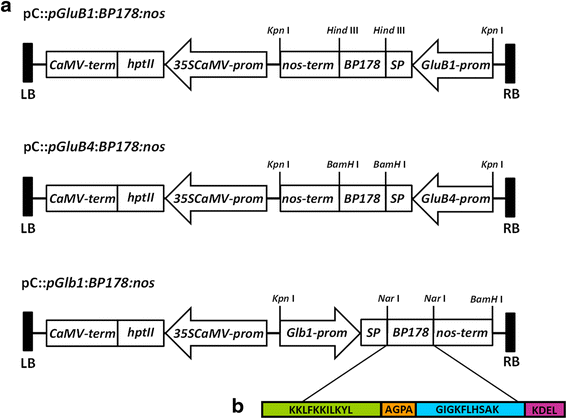
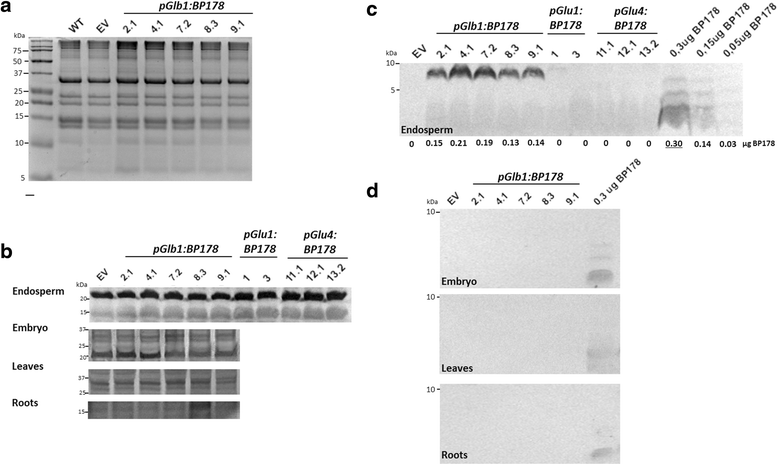
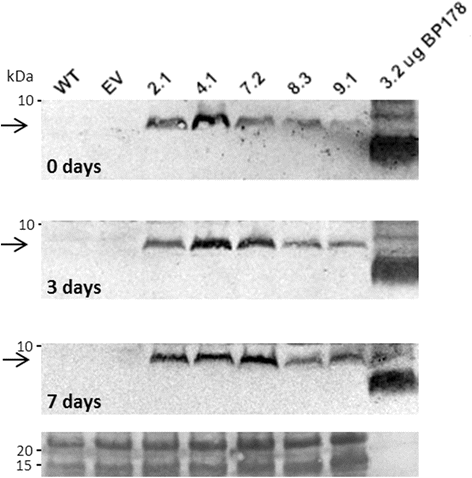
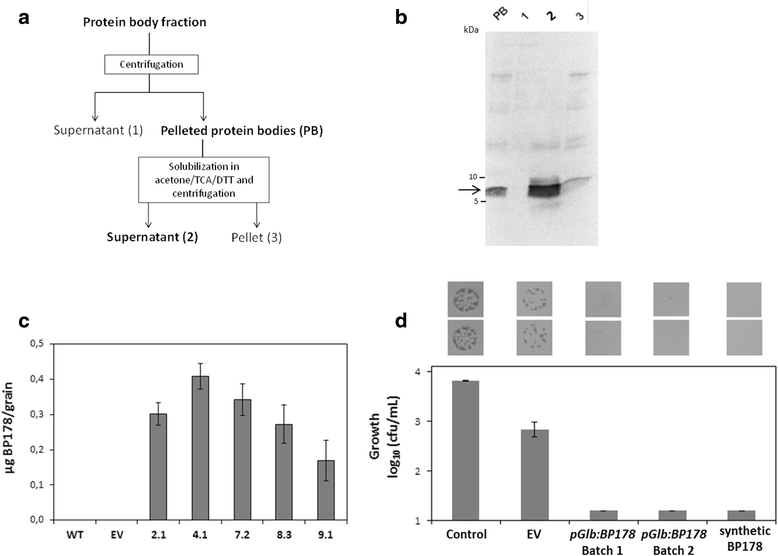
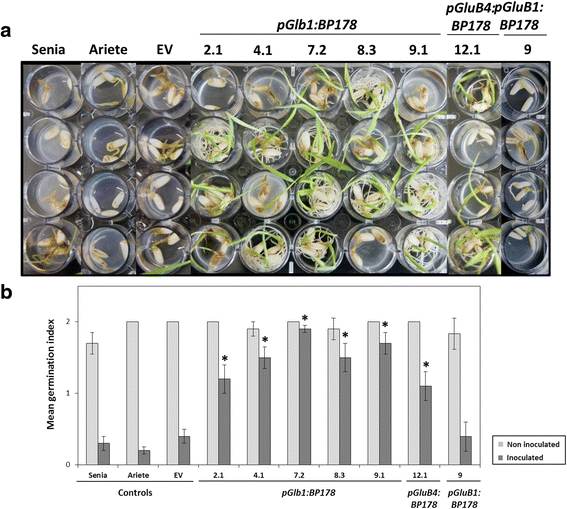
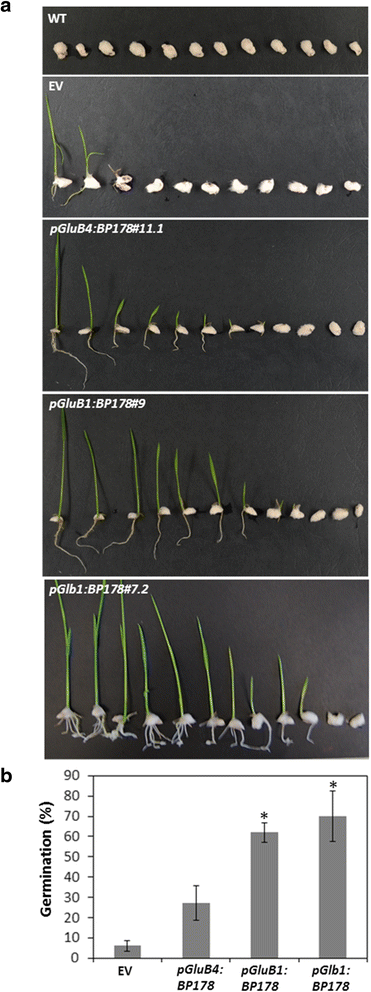
Similar articles
-
Production of cecropin A antimicrobial peptide in rice seed endosperm.BMC Plant Biol. 2014 Apr 22;14:102. doi: 10.1186/1471-2229-14-102. BMC Plant Biol. 2014. PMID: 24755305 Free PMC article.
-
Constitutive expression of transgenes encoding derivatives of the synthetic antimicrobial peptide BP100: impact on rice host plant fitness.BMC Plant Biol. 2012 Sep 4;12:159. doi: 10.1186/1471-2229-12-159. BMC Plant Biol. 2012. PMID: 22947243 Free PMC article.
-
High accumulation of bioactive peptide in transgenic rice seeds by expression of introduced multiple genes.Plant Biotechnol J. 2006 Sep;4(5):499-510. doi: 10.1111/j.1467-7652.2006.00199.x. Plant Biotechnol J. 2006. PMID: 17309726
-
Molecular farming using transgenic rice endosperm.Trends Biotechnol. 2022 Oct;40(10):1248-1260. doi: 10.1016/j.tibtech.2022.04.002. Epub 2022 May 10. Trends Biotechnol. 2022. PMID: 35562237 Review.
-
An overview on the strategies to exploit rice endosperm as production platform for biopharmaceuticals.Plant Sci. 2017 Oct;263:201-209. doi: 10.1016/j.plantsci.2017.07.016. Epub 2017 Jul 28. Plant Sci. 2017. PMID: 28818376 Review.
Cited by
-
Efficient production of antifungal proteins in plants using a new transient expression vector derived from tobacco mosaic virus.Plant Biotechnol J. 2019 Jun;17(6):1069-1080. doi: 10.1111/pbi.13038. Epub 2018 Dec 6. Plant Biotechnol J. 2019. PMID: 30521145 Free PMC article.
-
Deciphering the Mechanism of Action of the Antimicrobial Peptide BP100.Int J Mol Sci. 2024 Mar 19;25(6):3456. doi: 10.3390/ijms25063456. Int J Mol Sci. 2024. PMID: 38542427 Free PMC article. Review.
-
Screening and identification of BP100 peptide conjugates active against Xylella fastidiosa using a viability-qPCR method.BMC Microbiol. 2020 Jul 29;20(1):229. doi: 10.1186/s12866-020-01915-3. BMC Microbiol. 2020. PMID: 32727358 Free PMC article.
-
Synthetic lipopeptides that interact with lipopolysaccharides are potent bactericidal compounds against Xylella fastidiosa.Appl Environ Microbiol. 2025 Aug 20;91(8):e0073425. doi: 10.1128/aem.00734-25. Epub 2025 Jul 30. Appl Environ Microbiol. 2025. PMID: 40736421 Free PMC article.
-
Synthetic Peptides against Plant Pathogenic Bacteria.Microorganisms. 2022 Sep 3;10(9):1784. doi: 10.3390/microorganisms10091784. Microorganisms. 2022. PMID: 36144386 Free PMC article. Review.
References
Publication types
MeSH terms
Substances
LinkOut - more resources
Full Text Sources
Other Literature Sources
Medical

